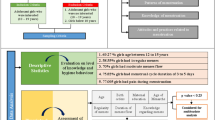Abstract
Introduction
One of the challenges to menstrual hygiene management in resource-limited settings is limited access to safe and affordable menstrual hygiene products. An alternative to the widely used sanitary pads is the menstrual cup, which has received less attention in low- and middle-income countries. This study was carried out to assess the perception on menstrual cup usage among teens and reproductive age group women assess attending a tertiary care institute in a rural setup in Andhra Pradesh.
Methodology
A prospective cross-sectional study was conducted among 164 teenage and reproductive age group women attending the Outpatient Department of Obstetrics and Gynecology with the help of a semi-structured, pretested and pre-piloted questionnaire to assess the perception of menstrual cup usage among the participants. Data were analyzed statistically using software, menstrual cup knowledge score was calculated based on data obtained from questionnaire.
Results
Most of the study participants (87.8%) were using sanitary pads during menstruation. Cloth was also used by some of the participants (11.59%). Only one participant (0.61%) was reported using menstrual cup. Majority of the participants [121 (73.7%)] reported that they had never heard of menstrual cup, whereas 43 [(26.3%)] study participants reported that they were aware of menstrual cup. Only 2(4.65%) out of 43 participants had a good knowledge on menstrual cup whose knowledge score was 12. Five (11.63%) out of 43 participants had got 0 score and remaining participants got the score between 0 and 12.
Conclusion
Most of the women were not aware of menstrual cup and even if they know about it, they do not have good knowledge about it. Awareness regarding menstrual cup should be promoted through media and awareness programs to reach everyone.


Similar content being viewed by others
Data Availability
All authors had access to the data and a role in writing this manuscript.
References
Eijk AM, Sivakami M, Thakkar MB, Bauman A, Laserson KF, Coates S, et al. Menstrual hygiene management among adolescent girls in India: a systematic review and meta-analysis. BMJ Open. 2016;6(3):e010290.
Divakar H, Singh R, Narayanan P, et al. Menstrual health and hygiene—study of knowledge attitudes and practices of obgyns on usage of menstrual cups. J Evid Based Med Healthc. 2020;7(8):372–6. https://doi.org/10.18410/jebmh/2020/80.
North BB, Oldham MJ. Preclinical, clinical, and over-the- counter post-marketing experience with a new vaginal cup: menstrual collection. J Women’s Health. 2011;20(2):303.
Howard C, Rose CL, Trouton K, Stamm H, Marentette D, Kirkpatrick N, et al. FLOW (finding lasting options for women): multicentre randomized controlled trial comparing tampons with menstrual cups. Can Fam Phys. 2011;57:e208–15.
Averbach S, Sahin-Hodoglugil N, Musara P, Chipato T. Duet for menstrual protection: a feasibility study in Zimbabwe. Contracept. 2009;769:463–8.
Mason L, Laserson K, Oruko K, Nyothach E, Alexander K, Odhiambo F, et al. Adolescent Waterlines. 2015;34:15–30.
Dasgupta A, Sarkar M. Menstrual hygiene: how hygienic is the adolescent girl? Indian J Community Med. 2008;33(2):77–80.
Van Eijk AM, Zulaika G, Lenchner M, Mason L, Sivakami M, Nyothach E, et al. Menstrual cup use, leakage, acceptability, safety, and availability: a systematic review and meta-analysis. Lancet Pub Health. 2019;4(8):e376–93.
Eti M, Shreya MS, Sailakshmi MPA. Knowledge about menstrual cup and its usage among medical students. Int J Reprod Contracept Obstet Gynecol. 2019;8:4966–70.
Kakani CR, Bhatt JK. Study of adaptability and efficacy of menstrual cup in managing menstrual health and hygiene. Int J Reprod Contracept Obstet Gynecol. 2017;6(7):3045–53.
Ballal SK, Bhandary A. Menstrual cup: awareness among reproductive women. Int J Reprod Contracept Obstet Gynecol. 2020;9(4):1382. https://doi.org/10.18203/2320-1770.ijrcog20201066.
Meghana S, Gomathy E. Knowledge, attitude, and practices regarding menstrual cup among reproductive women in a rural tertiary care Hospital. Int J Clin Obstet Gynaecol. 2021;5(2):211–3.
Paul KK, Chaudhuri S, Maiti A. Menstrual hygiene practices among women aged 15–49 years attending a medical college hospital in Kolkata: A cross-sectional study. J Family Med Prim Care. 2020;9(9):4699–704.
Acknowledgements
Nil.
Funding
The study was approved for ICMR – STS project for the year 2022.
Author information
Authors and Affiliations
Contributions
SS was involved in data collection and drafting the manuscript, SS, KG, VS and M Y were involved in conception, literature search, analysis of data and drafting the manuscript.
Corresponding author
Ethics declarations
Conflict of interest
The authors declare that they have no conflict of interest.
Ethical Committee Approval
IEC No: AIIMS/MG/IEC/2022–23/185 dated 29th July 2022; informed written consent was obtained from all the study participants.
Ethical standards
The article is in accordance with the ethical principles that have their origin in the Declaration of Helsinki. The authors certify that the study was conducted in accordance with Helsinki Declaration as revised in 2013 .
Consent for Publication
Informed consent of the patients for participation in research and for publishing in a journal.
Additional information
Publisher's Note
Springer Nature remains neutral with regard to jurisdictional claims in published maps and institutional affiliations.
Sangaraju Sreeja is a MBBS Student; Kavitha Garikapati is a Assistant Professor; Vijayan Sharmila is a Additional Professor; and M. Yamini is a Assistant Professor.
Rights and permissions
Springer Nature or its licensor (e.g. a society or other partner) holds exclusive rights to this article under a publishing agreement with the author(s) or other rightsholder(s); author self-archiving of the accepted manuscript version of this article is solely governed by the terms of such publishing agreement and applicable law.
About this article
Cite this article
Sreeja, S., Garikapati, K., Sharmila, V. et al. Perception on Menstrual Cup Usage Among Teens and Reproductive Age Group Women: A Cross-Sectional Study. J Obstet Gynecol India 73 (Suppl 1), 150–155 (2023). https://doi.org/10.1007/s13224-023-01825-0
Received:
Accepted:
Published:
Issue Date:
DOI: https://doi.org/10.1007/s13224-023-01825-0




